D-9 rocket complex with a P-29 ballistic missile
Development of the D-9 complex with the P-29 rocket began at SKB-385 (now the State Rocket Center) in the middle of 1963. The aim of the project was the creation of a liquid-propellant rocket with an intercontinental range and a set of facilities necessary for its use by promising submarines. For some time, the D-9 / P-29 complex was considered as an alternative to the D-8 / УР-100 system, but later it was decided to close one of the projects. In accordance with the decision of the USSR Council of Ministers on September 28 1964 weapons new submarines was supposed to be a rocket P-29. The development of the fleet version of the UR-100 was canceled.
Successful completion of the new project made it possible to significantly increase the effectiveness of strategic nuclear forces. With intercontinental missiles on board, the submarine could attack targets in the territory of a potential enemy without approaching its shores. As a result, it was possible to patrol at large distances from dangerous areas controlled by anti-submarine defense. Thus, the new project D-9 / P-29 was to be the most important step in the development of the country's nuclear shield.
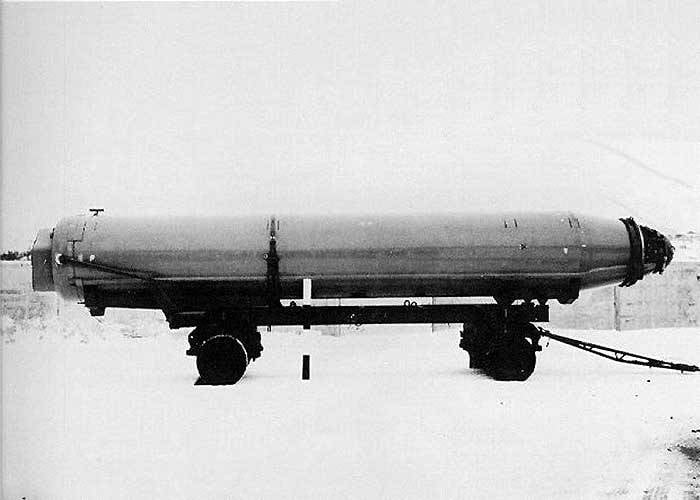
Rocket R-29 on the transport trolley. Photo Rbase.new-factoria.ru
SKB-385, headed by V.P. Makeev, already had some experience in developing liquid ballistic missiles of various classes. This experience should be used when creating a new product with enhanced characteristics. As a result, some of the ideas proposed and implemented in previous developments were present in the P-29 rocket design. In addition, several new technical solutions were proposed. So, to reduce the dimensions of the rocket while maintaining all other characteristics at the required level, several already worked out and completely new layout solutions were used.
Calculations showed that a new missile for submarines should be built on a two-stage scheme with a detachable head part. To reduce the length of the product, it was necessary to use the “recessed” placement of the engines, as well as a non-standard method of fastening the warhead and instrument compartment with control systems. Thanks to these and other ideas, the total length of the P-29 rocket was 13 m with a diameter of 1,8 m.
Both stages of the hull had a similar construction and should have been assembled from the so-called. wafer shells made of aluminum alloys. This gave a significant weight savings in comparison with other designs, and also allowed to provide the required strength. The entire internal volume of the steps was given under two tanks for oxidizer and fuel. The inter-tank compartment was absent, a double common bottom was used instead. The tail bottoms of both stages had a concave shape for mounting engines with a significant gain in the size of the entire product. In addition, the upper bottoms of a complex shape were used, due to the necessity of their conjugation with other units.
The upper bottom of the first stage due to the curved shape was supposed to accommodate the nozzle of the engine of the second stage. A similar detail of the second stage, in turn, was intended to install the head part. It is interesting that directly under the head fairing of the P-29 rocket it was proposed to place the instrument compartment with the control system. The combat unit, in turn, had to be placed between the instrument compartment and the second stage. In this case, the conical fairing of the warhead entered the corresponding recess of the bottom of the second stage.
The first stage of the rocket was equipped with an 4D75 fluid engine using asymmetric dimethyl hydrazine and nitrogen tetroxide. As part of the engine had a marching camera and two swing steering. The second stage was equipped with an 4D76 engine with one marching chamber mounted on a rocking system. The fuel system, including tanks, was designed for refueling with fuel and oxidizer at the plant, followed by ampulization. In this form, the rocket could be operated for a long time.
The new rocket was supposed to get the original combined-type control system with enhanced guidance accuracy characteristics. To improve accuracy in comparison with existing rockets, it was decided to improve inertial navigation devices by placing gyroscopes in a vacuum. In addition, it was proposed to equip the rocket with astrocorrection tools to more accurately determine the coordinates during the flight. As part of the project, the P-29 was able to successfully create and implement a new combined architecture of the guidance system, which was later repeatedly used on new missiles.
Under the conical head fairing of the new rocket, a monoblock warhead with a power of 1 Mt was to be placed. An interesting feature of the new project was the unusual placement of the combat unit, in which its head fairing was located towards the tail of the rocket. In addition, at the second stage, containers were provided for transporting false targets. The terms of reference for the new project stipulated the use of an anti-missile defense system. To this end, the rocket received a set of false targets, dropped simultaneously with the combat unit.
The first Russian intercontinental ballistic missile for submarines could attack targets at ranges up to 8000 km. With a starting weight of 33,3 T, the P-29 product was able to deliver a payload of up to 1100 kg to the target. When firing at a maximum range, the circular permissible deviation was estimated at 900 m.
For the D-9 complex, a new mine-type launcher was developed, in the design of which several unusual ideas were implemented. It was decided to abandon the rigid mounting of the rocket in the mine in the transport position. Instead, the product had to be held by rubber-metal shock absorbers, allowing small movements in different directions. In this case, the distribution of the load on the rocket body should be carried out not through the interaction points, but through relatively large annular zones. On the inner surface of the installation there were no separate guides. Instead, the missile shock absorbers during the launch had to interact directly with the body of the mine.
The use of a new launcher design has significantly reduced the size of the annular gap between the walls of the shaft and the rocket body. Among other things, this led to a decrease in the amount of water needed to fill the gap for a wet start. Due to this, the carrier of the missile complex needed smaller annular clearance tanks. It was also possible to reduce the time to prepare the launcher for launch. In addition, the possibility of rapid salvo firing with several missiles was provided.
The design of the rocket and the launcher made it possible to carry out firing from the depths to 55 m when the submarine was in motion and at sea agitation to 8 nodes. Shooting from a surface position was also allowed. All prelaunch operations should have been performed automatically by a command from a single console. Also, the console was responsible for the execution of launches. The control equipment of the D-9 complex had to be integrated into the composition of other onboard systems, which made it possible to automatically calculate the flight program and perform other operations.
The firing of the P-29 missiles was as follows. Having received the launch order, the carrier crew was to carry out pre-launch training. At the same time, their own coordinates were determined and the trajectory was calculated for hitting the specified target, after which the flight task was entered into the automatic system of the rocket. In addition, the rocket fuel tanks were pressurized and the annular gap was filled from a special tank. After equalizing the pressure, it became possible to open the lid of the shaft.
On command at the start, the first stage engine was started with a reduced load. With it, the rocket left the mine and went out of the water. After lifting into the air, the engine was brought to maximum thrust. Using the steering chambers of the 4ДХNUMX engine, the automation had to hold the rocket on the desired trajectory until the moment when the fuel was produced in the tanks of the first stage.
At the given point, the engine of the first stage was disconnected with its subsequent discharge. To separate the steps it was proposed to use an elongated charge and energy of pressurized gases. At the same time, there was a break in the power elements of the hull with the separation of the spent first stage.
After separation of the second stage an astronavigation session was to be held. In accordance with the updated data on its own coordinates, the rocket made a course correction and maintained the required direction of movement. After reaching the required height and speed, the second stage was to drop the combat unit and means of overcoming the missile defense. At the same time, on the screens of enemy radar stations, objects with similar parameters of EPR were to appear, one of which was a real combat unit, and the rest were false targets.
The development of the D-9 / P-29 project took several years. By the end of the sixties, the new rocket was ready for testing. The first stage of inspections was launched in September 1968 of the year using a submerged stand. The first launch of 23 September ended in an accident. The product left the launcher, which was under water, but there was a premature stopping of the engine. The rocket did not rise to the required height, and then fell into the water. The liquid remaining in the tanks exploded, creating a cloud of combustion products and fuel components. The tests had to be interrupted to eliminate the consequences of the accident.
The next launch took place in a few days and was carried out without immersing the stand. This throwing start was regular. Later five more inspections took place with shooting from the submerged stand. Completion of the first stage of testing allowed to proceed to inspections at the land test site.
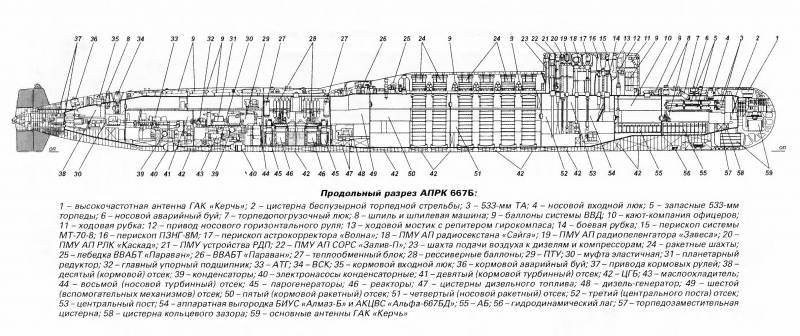
The scheme of the submarine pr 667B. Figure Apalkov Yu.V. "Submarines of the Soviet Navy 1945-1991. Volume II"
The site for the second part of the test was the Nenoks test site on the shore of the White Sea. From March 1969 to November 71, 20 rocket launches were completed in complete configuration. Field tests were forced to be interrupted due to an accident during one of the launches. At the next launch, an explosion of the first-stage engine followed by the destruction of the rocket and serious damage to the launcher. Repairing damaged systems took several weeks, after which the tests were continued. During inspections at the land test site, 20 test runs were performed.
In the third stage of the test was planned to use the submarine carrier. In order to test the promising missile system, at the end of 1964, the decision was made to develop a new submarine. The first carrier of the D-9 complex was to become the K-145 nuclear submarine of the 658 project. TsKB-16 was commissioned to create a modernization project for the 701 submarine, which involves the installation of new launch systems and other equipment. A new project was developed and implemented by the beginning of the next decade. At the end of 1971, the K-145 was ready to begin testing the new rocket.
25 December 1971 of the K-145 submarine launched the P-29 rocket for the first time, becoming the world's first submarine carrier of intercontinental ballistic missiles. The launch took place on one of the White Sea landfills, from a surface position. Due to the ice situation in the water area, the underwater launch was impossible. During the first start, all the systems of the complex and the rockets worked out normally. The following three launches were also considered successful.
In March 1972, the fifth launch took place, which, however, ended in an accident. According to reports, during the preparation for the underwater launch, the tanks of the experimental rocket were destroyed with fuel and fuel leakage, which led to their mixing. It was decided to immediately float and open the cover of the launcher. After the ascent of the rocket exploded, a large piece, representing the upper half of the rocket, was thrown overboard. The launcher received some damage. Repair K-145 continued until August.
From 21 August to 28 November 1972, eight more starts were made, which were not accompanied by any problems or accidents. Two test launches of this series were performed on training targets in the Pacific Ocean, which made it possible to confirm the possibility of firing a new missile at an intercontinental range.
12 March 1974 of the D-9 missile system with a ballistic missile R-29 was adopted. By this time, the design of the nuclear submarine 667B "Murena", which was to become the main carrier of the new complex, was developed. Already in December, the main boat of the new project K-72 entered into operation on 279. Over the next five years, the fleet received another 17 submarine cruiser with the D-9 missile system. The submarine of the project "Moray" carried on 12 launchers for missiles R-29. The mines were located behind the logging fence in pairs. Due to the relatively large length of the launchers, the submarines had a characteristic superstructure behind the cabin fencing. Submarine equipment made it possible to carry out salvo firing with several missiles, right up to the entire ammunition load.
At the end of 1976, the K-118 boat of the 601 project, converted from the original 629 project, was commissioned. Tests of this submarine showed the inexpediency of further upgrading the existing technology on the new project. More boats 601 project was not built and not rebuilt.
After the start of the serial construction of the nuclear submarine of the 667B project, the development of an upgraded version of the missile complex, designated as D-9D, began. The main difference of this system was the P-29D rocket, which lost its means of overcoming the missile defense. Due to their exclusion, it was possible to increase the fuel supply and bring the firing range to 9100 km. Also, some nuances of the project regarding the production of serial products were changed.
The D-9D complex received several 667B submarines during the modernization. In addition, they were regularly equipped with four submarines of the 667BD Murena-M project. In addition to the new Murena-M missiles, they were equipped with four additional launchers placed in an elongated body. At the same time, however, boats of this type could not perform a volley from 16 launches. Ammunition was divided into two parts: 12 missiles could be fired with the first salvo, and the remaining 4 was proposed to be used in the second.
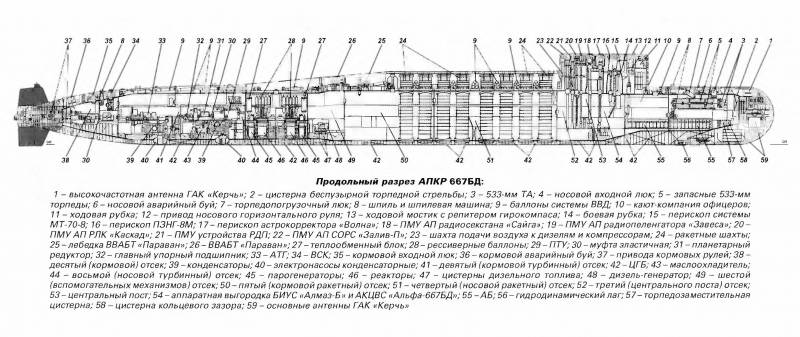
The scheme of the submarine pr. 667BD. Figure Apalkov Yu.V. "Submarines of the Soviet Navy 1945-1991. Volume II"
In 1977, the D-9P complex with the P-29Р rocket was adopted. This system was another version of the modernization of the existing complex, but differed in a number of features and characteristics. In the future, the P-29P rocket became the basis for several new products, which can be conventionally combined into a separate family. Several stages of the modernization of the D-9Р complex with the creation of a number of new missiles made it possible for several decades to retain in armament strategic armaments with high characteristics. Late modifications of the P-29P family of rockets are still in use.
Over the years of the P-29 missiles (with a number of modifications of the P-29Р family), more than 350 launches were performed, most of which ended with the successful defeat of conventional targets. Only a few dozen missiles for one reason or another could not solve the tasks.
In the early nineties, the gradual decommissioning of the P-29 missiles and their carriers began. Thus, from 1994 to 2004, all submarines of the 667B project were decommissioned, and in 1996-99 the fleet lost all boats of the type 667BD. The completion of the operation of the carriers made it impossible to further exploit the remaining P-29 missiles. All available products of the family were disposed of as useless.
The product P-29 was the first Russian submarine missile capable of hitting targets at ranges over 5500 km. The emergence of such weapons has significantly increased the strike potential of the naval component of the strategic nuclear forces, as well as reducing the risks for submarines on alert. In addition, the P-29 rocket and the D-9 complex became the basis for several new developments of a similar purpose. The latest modifications of the systems of this family still remain in service and are one of the most important elements of the national nuclear shield.
Based on:
http://makeyev.ru/
http://rbase.new-factoria.ru/
https://defendingrussia.ru/
http://deepstorm.ru/
http://navy.su/
Shirokorad A.B. Weapons of the domestic fleet. 1945-2000. - Minsk: “Harvest”, 2001
Apalkov Yu.V. Submarines of the Soviet Navy 1945-1991 Volume II: - M: Morkniga, 2011
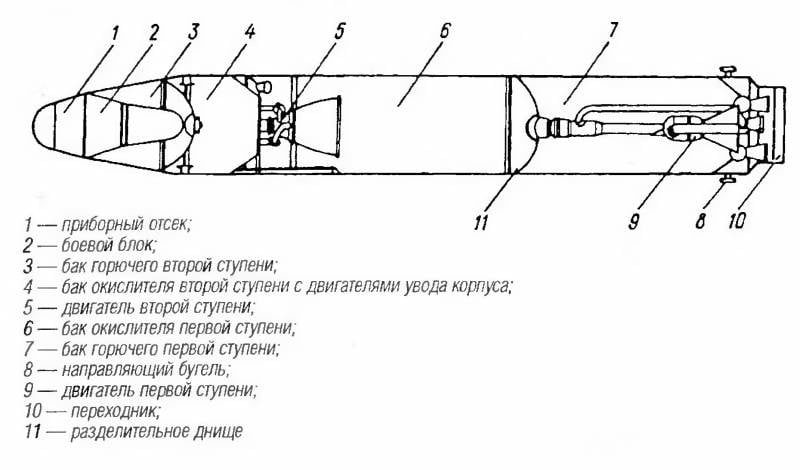
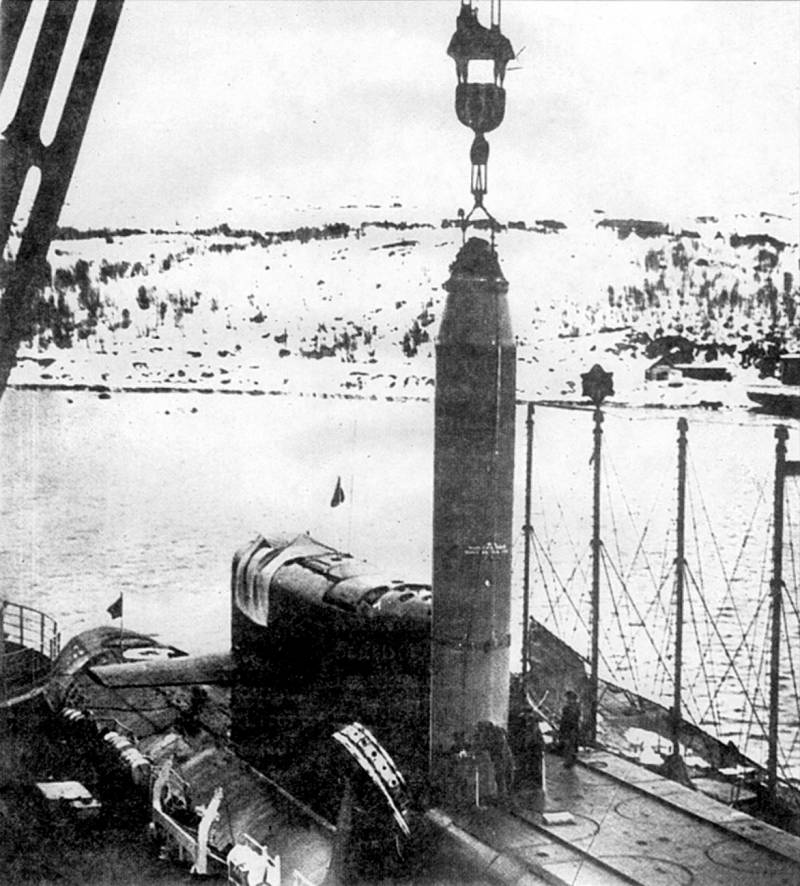
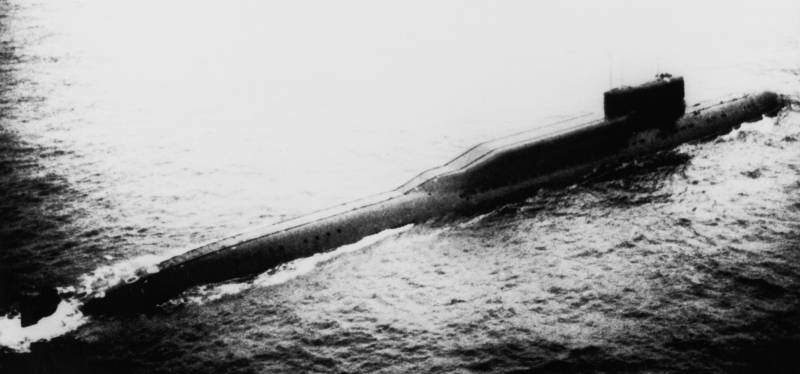
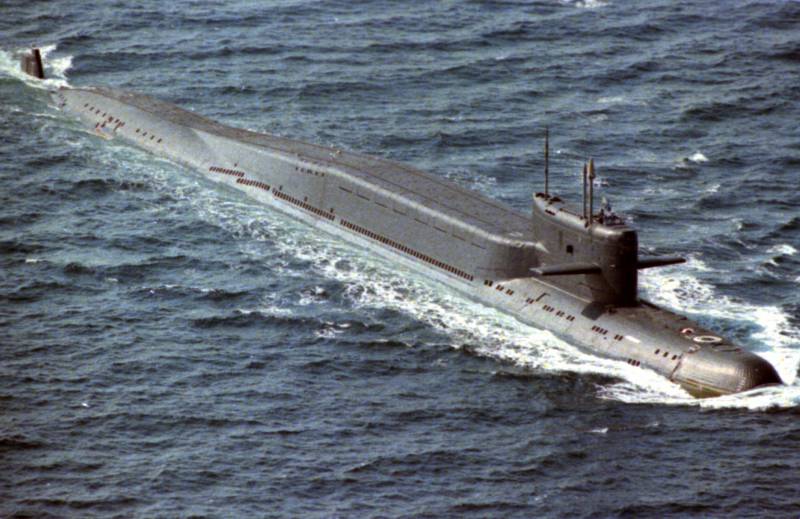
Information